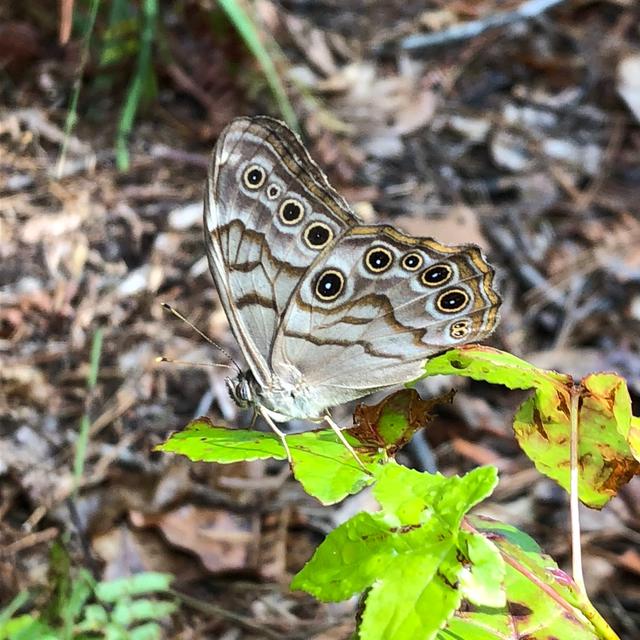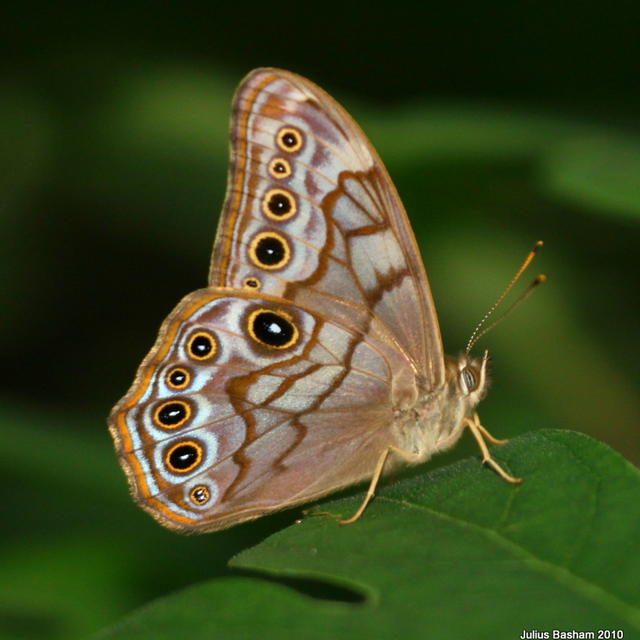Creole Pearly-eye
Enodia creola (Skinner, 1897)
Family: Nymphalidae
Subfamily: Satyrinae
Identification: Male forewing is pointed; upperside is brown with raised patches of dark scales along veins. Underside of both sexes is tan; forewing has a straight submarginal row of 5 spots; dark line along inner side of spot row arches outwardly at the cell.
Wing Span: 2 5/16 - 2 3/4 inches (5.9 - 7 cm).
Life History: Adults perch on tree trunks during the day, up to 10 feet above ground. Males perch and wait for females in late afternoon or on cloudy days. Females lay eggs singly on or near the host plants; caterpillars feed on leaves at night and hide at the base of the plant during the day. Caterpillars hibernate.
Flight: Two broods in the north from June-September, three broods in the south from April-September.
Caterpillar Hosts: Switch cane (Arundinaria tecta) in the grass family (Poaceae).
Adult Food: Rotting fruit, sap, dung, carrion; never flower nectar.
Habitat: Dense moist woods near large swamps, dense upland forests in the southern Appalachians.
Range: Southeastern states from North Carolina and central Georgia west to eastern Oklahoma and eastern Texas. Does not occur in southeast Alabama, southern Georgia, or Florida.
Conservation: Swamp forest habitats are gradually being encroached on, although several large preserves are extinct.
NCGR: G4 - Apparently secure globally, though it might be quite rare in parts of its range, especially at the periphery.
Management Needs: Conserve and minimally manage remaining habitats under secure land ownership.
Comments: NULL
BAMONA Shop
Please donate!
We depend on donations to keep Butterflies and Moths of North America freely available. We want to express our gratitude to all who showed their support by making a contribution this year. You can donate to support this project at any time.
Advertise with us!
Do you have a product or service that you think would interest BAMONA users? If you would like to advertise on this website, contact us by email, or use the contact form and select the "Advertising" category.
Verified Sightings
Displaying 1 - 24 of 496 verified sightings

Observation date: Aug 03, 2025
Submitted by: Alison Davies
Region: Lexington County, South Carolina, United States
Verified by: Dennis Forsythe
Verified date: Aug 04, 2025

Observation date: Aug 24, 2024
Submitted by: Team-Chick
Region: Virginia, York County, United States
Verified by: jmgesell
Verified date: Jul 12, 2025

Observation date: Aug 24, 2024
Submitted by: Team-Chick
Region: Virginia, York County, United States
Verified by: jmgesell
Verified date: Jul 12, 2025

Observation date: May 30, 2025
Submitted by: AJ Trently
Region: Lake County, Tennessee, United States
Verified by: James Steen
Verified date: Jun 02, 2025

Observation date: Jun 03, 2024
Submitted by: Phil.Delestrez
Region: Georgia, White County, United States
Verified by: Mikelchap
Verified date: Jun 09, 2024

Observation date: May 22, 2024
Submitted by: Dennis Forsythe
Region: Charleston County, South Carolina, United States
Verified by: Dennis Forsythe
Verified date: May 23, 2024

Observation date: Apr 24, 2024
Submitted by: labkitten
Region: Orangeburg County, South Carolina, United States
Verified by: Dennis Forsythe
Verified date: Apr 25, 2024

Observation date: Aug 31, 2023
Submitted by: Cascade Colors
Region: Cumberland County, Tennessee, United States
Verified by: James Steen
Verified date: Sep 02, 2023

Observation date: Aug 06, 2023
Submitted by: Tdloyd
Region: Sumner County, Tennessee, United States
Verified by: James Steen
Verified date: Aug 08, 2023

Observation date: Jun 24, 2023
Submitted by: cklindsey
Region: Harrison County, Texas, United States
Verified by: jwileyrains
Verified date: Jul 11, 2023

Observation date: Apr 24, 2022
Submitted by: Ken Cheeks
Region: Aiken County, South Carolina, United States
Verified by: Dennis Forsythe
Verified date: Dec 16, 2022

Observation date: Oct 14, 2022
Submitted by: Ken Cheeks
Region: Aiken County, South Carolina, United States
Verified by: Dennis Forsythe
Verified date: Oct 22, 2022

Observation date: Jul 04, 2020
Submitted by: cosmic_cat
Region: Gregg County, Texas, United States
Verified by: jwileyrains
Verified date: Oct 16, 2022

Observation date: Aug 25, 2022
Submitted by: KenL
Region: Surry County, Virginia, United States
Verified by: drerbium
Verified date: Sep 28, 2022

Observation date: Aug 13, 2017
Submitted by: dbryant562
Region: Richland County, South Carolina, United States
Verified by: Dennis Forsythe
Verified date: Aug 18, 2022

Observation date: Aug 09, 2022
Submitted by: Teamdean
Region: Virginia, United States
Verified by: drerbium
Verified date: Aug 14, 2022

Observation date: Jun 12, 2022
Submitted by: jf.flynn.jr@gma...
Region: Macon County, North Carolina, United States
Verified by: Dennis Forsythe
Verified date: Jun 24, 2022

Observation date: Sep 16, 2016
Submitted by: ms722
Region: Sumner County, Tennessee, United States
Verified by: James Steen
Verified date: May 30, 2022

Observation date: May 06, 2022
Submitted by: Jonathan Clark
Region: Catahoula Parish, Louisiana, United States
Verified by: CA Ivy
Verified date: May 14, 2022

Observation date: Aug 20, 2016
Submitted by: Mark Salvato
Region: Nassau County, Florida, United States
Verified by: John Calhoun
Verified date: Dec 10, 2021

Observation date: Jun 07, 2020
Submitted by: Tommie Rogers
Region: Marion County, Tennessee, United States
Verified by: S. J. Stedman
Verified date: Nov 01, 2021

Observation date: Aug 26, 2021
Submitted by: Jonathan Clark
Region: Catahoula Parish, Louisiana, United States
Verified by: CA Ivy
Verified date: Oct 31, 2021

Observation date: Apr 14, 2018
Submitted by: NaturallyWade
Region: Aiken County, South Carolina, United States
Verified by: Dennis Forsythe
Verified date: May 31, 2021

Observation date: Aug 15, 2016
Submitted by: KenL
Region: James City County, Virginia, United States
Verified by: drerbium
Verified date: Jan 01, 2021
- 1 of 21
- next ›






